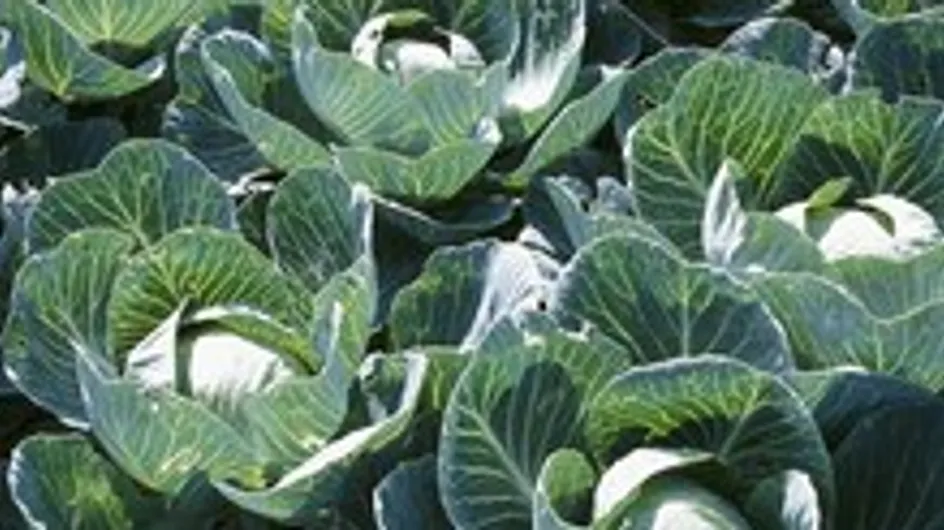All varieties of cabbage are rich in minerals (potassium, sulphur, phosphorus, calcium, magnesium and iron) and vitamins (C, A, B9, E and K). Cabbage is all good nutrition-wise. It's packed with minerals, toning and energetic properties, provided of course that it's eaten shortly after purchase and not cooked for too long, to retain the goodness. Its revitalising and diuretic qualities are highly prized for detox. The only part of cabbage that is normally eaten is the leafy head and the round cluster of young leaves, not the darker, maturer outer leaves. We often talk about the head of a cabbage because of its round shape, but not all forms of cabbage have this round head (for example, broccoli is made up of several small branches and is not round!).
Try our cabbage recipes!
3 preparation tips:
1) Wash the cabbage in vinegar water to remove insects.
2) To keep the colour of green cabbage, blanch in boiling salted water and vinegar for 2 to 5 minutes and then immediately plunge into a bath of iced water (cold water and ice) to set the chlorophyll which gives it its green colour.
3) Make it more palatable by adding a piece of dry bread to the cooking water and a pinch of baking powder to absorb the sulphur that's responsible for the strong smell. This also helps to set the colour.
Curly green cabbage (Savoy cabbage) and green cabbageDescription
Savoy cabbage has curly green leaves and is dark green on the outer leaves, which become lighter inwards. It grows from September to June. Green cabbage has smooth, fairly thin leaves which are dark green and can turn blue/purple at the edges. It is available from late autumn.
Uses
Both are cooked to taste or sauteed, but rarely eaten raw (better blanched for 5 minutes).
Goes well with:
White meat, minced meat, onions, stews, soups, stuffed, with dried vegetables, soft cheeses and oily fish.
Red cabbageDescription
A cabbage with smooth purple leaves, with pretty white stripes when cut. It becomes fuchsia in colour when soaked in vinegar-based dressing (the acidity of vinegar gives it this colour). When cooked it becomes almost blue, and can taste a litlle sour.
Uses
Raw in salads, steamed or in casserole.
Goes well with:
Carrots, apples, tuna, chestnuts, bacon, paprika, bananas, red and cured meat.
White cabbageDescription
A round cabbage with smooth white or pale green leaves. When raw, it has a fresh flavour that's sour and spicy at the same time. When cooked, it absorbs the flavour of whatever you cook it with. It is harvested in June.
Uses Raw in salad, coleslaw, cooked in a pressure cooker or in sauerkraut.
Goes well with:
Celery, green apples, nuts, roquefort cheese, orange, juniper, cured meat and mustard.
Brussels sproutsDescription
These are small round cabbages that hang in clusters on a central stalk. There are many varieties which can be found on shelves from the end of September to March. Brussels are very rich in Vitamins B9, B1, fibre and Provitamin A.
Uses
It is not a good idea to eat them raw, but to blanch slightly (5 minutes) before slicing for cold salad, for example. Otherwise, they are good steamed (for no more than 8 minutes) or sauteed in a pan.
Goes well with:
Bacon, roasts, Munster, blue and other strong cheeses, cumin and lemon.
Cauliflower and green cauliflowerDescription
Quite round in shape, these are white, with fine grains and close branches. The leaves at the base should be pale green and tight too. Light green cauliflower also exists.
Uses
Cauliflower cheese, mashed potatoes, fritters, grated or eaten raw (crudités and dips).
Goes well with:
Crème fraiche, mascarpone, cinnamon, cheese, lemon, salmon, curry and chives.
BroccoliDescription
In the fields it is found on a central stem at the end of which grow several litlle branches. At the base of the stem, green leaves grow high enough to protect the head of broccoli. The branches have compact grains and their colour ranges from yellow-green to green-blue-violet or green. Broccoli is rich in Vitamin C and tastes fine, soft and slightly sweet because it is high in carbohydrate. Find it on shelves from July to November.
Uses
Raw or cooked in a gratin, quiche, mashed potatoes, soup and stir fry.
Goes well with:
Cheese, salmon and tuna, parmesan, tomatoes, olive oil, almonds and white meat.
RomanescoDescription
Also known as round broccoli, this is a little cauliflower-like vegetable with little pointy heads like pyramids, light green in colour.
Uses
Steamed and then sauteed, raw in salads or as a dip.
Goes well with:
White fish, fennel, fine herbs, hard cheeses and Asian recipes.
Chinese cabbage (Po-Tsaï)Description It looks like a Romanesco cabbage with an elongated shape, has large, thin, white sides and pale green, curly leaves. It has a mild but fresh taste when eaten raw, that goes well with many recipes without being too dominant.
Uses
Enjoy raw, in salads, grated, boiled or stir-fried in a wok.
Goes well with:
Soya beans, sauteed beef, Asian spices, nuoc-mâm sauce, soy sauce and cashew nuts.
With thanks to Editions Minerva.













